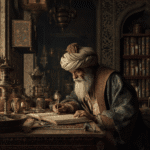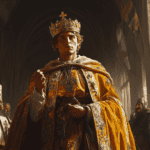
Pope Sylvester II, born Gerbert of Aurillac, stands out as a figure whose scientific curiosity and reformist energy helped lay the groundwork for the intellectual revival of medieval Europe. His short papacy (999–1003) belied an outsized impact: he bridged worlds, fought for moral reform, and promoted a new openness to science that would ripple through the centuries.
Early Life and Scientific Curiosity
Gerbert’s origins were humble: born around 946 A.D. to a peasant family in France, he displayed an early fascination with the natural world while tending sheep, gazing up at the stars, and seeking patterns in nature. A local priest noticed his intellect and arranged for an education at a Benedictine monastery, nurturing his love of learning. As a student, Gerbert absorbed the quadrivium curriculum (geometry, mathematics, astronomy, and music), classical authors, and Christian theological texts.
A defining episode in Gerbert’s life occurred when he traveled with Count Borrell II of Barcelona to Catalonia and beyond, gaining access to the great libraries and schools of Al-Andalus. Here, he was introduced to advanced mathematics, astronomy, and philosophy from both Arabic and Greco-Roman sources, making contacts with prominent Muslim scholars. Gerbert became fluent in Latin and gained an understanding of Arabic, allowing him to translate scientific works into Latin and introduce them to his monastic peers.
Promoting Scientific Tools and Methods
Reintroduction of the Abacus and Arabic Numerals
One of Gerbert’s greatest accomplishments was the reintroduction of the abacus for calculation. At a time when finger counting limited the scope of arithmetic, the abacus allowed for more complex operations; he taught its use to his students, merchants, and clerics, revolutionizing the way business and education were conducted. Notably, he is credited as the first Christian scholar to teach mathematics using Hindu–Arabic numerals, centuries ahead of their widespread adoption in the West.

The Armillary Sphere and the Astrolabe
Gerbert constructed and introduced the armillary sphere: a model representing the celestial sphere with rings and bands, instrumental for understanding the movement of stars and planets. He also wrote early treatises on the astrolabe, an instrument for measuring the positions of celestial bodies and aiding navigation. Such devices became fundamental in medieval scientific education.
The First Mechanical Timekeeping Devices
Gerbert is alleged to have invented a primitive mechanical clock or pendulum mechanism at the University of Magdeburg around 996. The device marked the hours more reliably than sundials or hourglasses, impacting monastery schedules and daily life. Though the technology would take centuries to mature, his innovation marked a turning point in timekeeping science.
The Hydraulic Organ
Not only limited to abstract theory, Sylvester II also built a revolutionary hydraulic organ using brass pipes powered by water, a feat combining science, engineering, and music. This improved upon earlier musical instruments and exemplified the blending of artistic and scientific ingenuity.
Papal Reforms: Simony and Clerical Morality
Upon becoming Pope Sylvester II in 999, Gerbert undertook vigorous reforms to rectify simony (the sale of church offices) and lascivious behavior among the clergy. He insisted only men of virtue and competency should ascend to bishoprics, and championed clerical celibacy as a standard. By emphasizing merit and moral integrity, Sylvester hoped to renew the Church’s spiritual authority and credibility.

Encouragement of Scholarship
Sylvester II’s campaign for educational renewal extended beyond the Church. He was a sought-after teacher, amassing a considerable book collection and sharing it widely among Christian scholars. His writings on geometry, mathematics, astronomy, and philosophy helped preserve and transmit classical and Arabic knowledge at a time when Europe’s intellectual infrastructure was threadbare.
Political Vision and International Diplomacy
Partner to Otto III and European Unity
As pope, Sylvester II was closely allied with Holy Roman Emperor Otto III. Together they envisioned a renewed Christian Roman Empire, one where secular and ecclesiastical authority worked in harmony to further civilization and peace. His role as political mediator was notable in granting Hungary and Poland their first archbishoprics and supporting the spread of Christianity into Eastern Europe. Sylvester’s diplomatic reach extended to Russia, the Balkans, Scandinavia, and Italy, strengthening papal influence and forging new connections.
Sylvester supported abbeys seeking autonomy from local bishops and nobles, confirming their right to elect abbots and appeal directly to the pope. This policy both liberated monastic communities and consolidated papal power, laying groundwork for later medieval reforms.

Myths and Accusations of Sorcery
Gerbert’s dazzling intellect and rapid rise incited envy and suspicion. Rivals spread rumors of sorcery and demonic pacts, at times attributing his scientific achievements and mechanical proficiency to black magic. Stories abounded of a “talking bronze head” and alliances with malevolent spirits; such myths, though false, reflected both the ignorance and awe his learning inspired. Despite these slanders, Gerbert’s legacy as a beacon of reason and science persevered.
Lasting Influence
Sylvester II’s impact endures in two principal ways: through the mechanics and mathematics that laid foundations for Europe’s scientific awakening, and through his role as a reforming pope committed to discipline, merit, and learning. His blending of Christian values and scientific inquiry helped shape a new era of thought, influencing later figures of the Renaissance and beyond.
Pope Sylvester II lived at a time when science and religion were often considered incompatible, yet he proved otherwise. Drawing upon Arabic and classical insight, he ushered in mathematical tools, timekeeping devices, astronomical instruments, and educational reforms. As both scholar and reformer, he challenged the Church to embrace learning, virtue, and innovation. His life, an emblem of curiosity, resilience, and integrative thinking, demands remembrance as a forerunner of the scientific spirit in a religious age





How well-put that “Europe’s intellectual infrastructure was threadbare.” I haven’t explored all the articles on this wonderful site yet, but I hope more has been written about the Arab contribution to not only bringing back the scientific and philosophic contributions of the Greeks but also to the actual creation of fiction – think Ali Baba adventures and the 1000 stories, etc. – that formed the basis for so much that was to come. The origin of Grail stories and the many other quests. People were starving for something to read other than religious treatises!